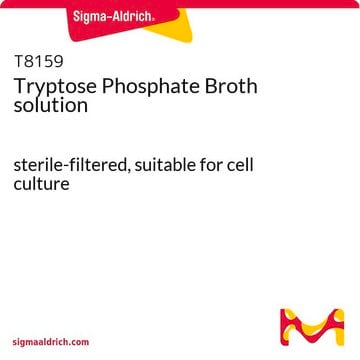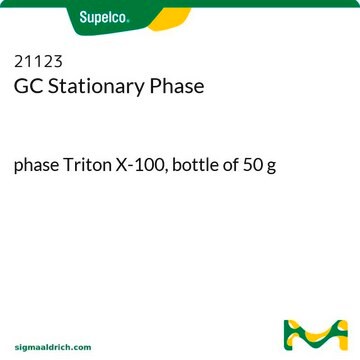If this product has an expiration or retest date, it will be shown on the Certificate of Analysis (COA, CofA). If there is no retest or expiration date listed on the product's COA, we do not have suitable stability data to determine a shelf life. For these products, the only date on the COA will be the release date; a retest, expiration, or use-by-date will not be displayed.
For all products, we recommend handling per defined conditions as printed in our product literature and website product descriptions. We recommend that products should be routinely inspected by customers to ensure they perform as expected.
For products without retest or expiration dates, our standard warranty of 1 year from the date of shipment is applicable.
For more information, please refer to the Product Dating Information document: https://www.sigmaaldrich.com/deepweb/assets/sigmaaldrich/marketing/global/documents/449/386/product-dating-information-mk.pdf
T8787
Triton™ X-100
for molecular biology
Sinônimo(s):
t-Octilfenoxipolietoxietanol, Polietilenoglicol terc-octilfenil éter
Selecione um tamanho
Selecione um tamanho
About This Item
Produtos recomendados
fonte biológica
synthetic (organic)
grau
Molecular Biology
for molecular biology
descrição
non-ionic
Formulário
liquid
peso molecular
micellar avg mol wt 80,000
average mol wt 625
número de agregação
100-155
técnica(s)
protein purification: suitable
protein quantification: suitable
western blot: suitable
Impurezas
<1.00% water (Karl Fischer)
pH
9.7
CMC
0.2-0.9 mM (20-25°C)
pf
6 °C
temperatura de transição
cloud point 65 °C
pour point ~7 °C
solubilidade
water: 0.1 mL/mL, clear to slightly hazy, colorless to faintly yellow
densidade
1.06 g/mL at 25 °C (lit.)
traços de cátion
Fe: <5 ppm
K: <0.05%
Na: <0.1%
heavy metals: <5 ppm
HLB
13.5
aplicação(ões)
hematology
histology
atividade externa
DNase and RNase, none detected
temperatura de armazenamento
room temp
cadeia de caracteres SMILES
CC(C)(C)CC(C)(C)c1ccc(OCCOCCOCCOCCOCCOCCOCCO)cc1
InChI
1S/C28H50O8/c1-27(2,3)24-28(4,5)25-6-8-26(9-7-25)36-23-22-35-21-20-34-19-18-33-17-16-32-15-14-31-13-12-30-11-10-29/h6-9,29H,10-24H2,1-5H3
chave InChI
HNLXNOZHXNSSPN-UHFFFAOYSA-N
Procurando produtos similares? Visita Guia de comparação de produtos
Descrição geral
Aplicação
- Em imuno-histoquímica para corar retinas montadas em lâminas em camada plana[3]
- Juntamente com PBS (solução salina tamponada com fosfato) gelado em suspensão de células para análise de DNA celular e ensaio de anexina V[4]
- Para permeabilizar células durante estudos microscópicos imunofluorescentes[5]
- Como controle positivo no ensaio de LDH para determinar a integridade da membrana celular[6]
- Para estimar a atividade da lipase no plasma pós-heparina usando o procedimento radioenzimático de Belfrage e Vaughan modificado[7]
- Para o preparo de extrato de proteínas de membrana externa[8]
- Como componente de tampão de extração, juntamente com tris-HCl, NaCl, CaCl2, ZnCl2, Brij 35, para homogenização de células pulmonares de camundongos[9]
- No tratamento de cortes de tecido para marcação para imunofluorescência[10]
Ações bioquímicas/fisiológicas
Características e benefícios
- Ideal para aplicações sensíveis de pesquisa em biologia molecular
- Testado para DNase e RNase
- Detergente não iônico umectante
- Agente umectante e emulsificante superior
- Surfactante altamente versátil
Outras notas
Informações legais
produto comparável
Palavra indicadora
Danger
Frases de perigo
Declarações de precaução
Classificações de perigo
Acute Tox. 4 Oral - Aquatic Acute 1 - Aquatic Chronic 1 - Eye Dam. 1 - Skin Irrit. 2
Código de classe de armazenamento
10 - Combustible liquids
Classe de risco de água (WGK)
WGK 3
Ponto de fulgor (°F)
483.8 °F - closed cup
Ponto de fulgor (°C)
251 °C - closed cup
Equipamento de proteção individual
Eyeshields, Faceshields, Gloves, type ABEK (EN14387) respirator filter
Escolha uma das versões mais recentes:
Certificados de análise (COA)
Não está vendo a versão correta?
Se precisar de uma versão específica, você pode procurar um certificado específico pelo número do lote ou da remessa.
Já possui este produto?
Encontre a documentação dos produtos que você adquiriu recentemente na biblioteca de documentos.
Os clientes também visualizaram
Artigos
Organoid culture products to generate tissue and stem cell derived 3D brain, intestinal, gut, lung and cancer tumor organoid models.
Protocolos
Preparation for biodegradable nanoparticles and their use in transfection protocols .
How to stain organoids? A complete step-by-step protocol for immunofluorescent (IF) and immunocytochemical (ICC) staining of organoid cultures using antibodies
Conteúdo relacionado
Cell lysis and protein extraction methods overview various techniques, from detergent solubilization to mechanical disruption, supporting research needs.
Uma visão geral dos métodos de lise celular e extração de proteínas, incluindo diversas técnicas, da solubilização em detergente à ruptura mecânica, para fins de embasar a pesquisa.
Three-dimensional (3D) printing of biological tissue is rapidly becoming an integral part of tissue engineering.
-
How can I determine the shelf life / expiration / retest date of this product?
1 answer-
Helpful?
-
-
How is shipping temperature determined? And how is it related to the product storage temperature?
1 answer-
Products may be shipped at a different temperature than the recommended long-term storage temperature. If the product quality is sensitive to short-term exposure to conditions other than the recommended long-term storage, it will be shipped on wet or dry-ice. If the product quality is NOT affected by short-term exposure to conditions other than the recommended long-term storage, it will be shipped at ambient temperature. As shipping routes are configured for minimum transit times, shipping at ambient temperature helps control shipping costs for our customers. For more information, please refer to the Storage and Transport Conditions document: https://www.sigmaaldrich.com/deepweb/assets/sigmaaldrich/marketing/global/documents/316/622/storage-transport-conditions-mk.pdf
Helpful?
-
-
What is the concentration of Triton X-1000 T8787?
1 answer-
This product is considered a neat or pure liquid at 100% active ingredient. The maximum allowable water content is 1%. This value is lot specific and reported on the Certificate of Analysis.
Helpful?
-
-
Hello, I am wondering how could I find the purity of the Triton X-100 in your products. Your help and advice is appreciated. Kind regards, Soheil
1 answer-
This product is 100 % active ingredient. The maximum allowable water content is 1 % for this product.
Please see the link below to review a sample Certificate of Analysis:
https://www.sigmaaldrich.com/certificates/sapfs/PROD/sap/certificate_pdfs/COFA/Q14/T8787-VAR0000267901.pdfHelpful?
-
-
Can pure Triton X-100 be stored at and remain stable at less than 4C?
1 answer-
This product has been subjected, in the pure form, to temperatures at or near the pour point (1 °C) with no degradation. At lower temperatures, the material may become viscous and require gentle warming to ensure homogeneity. In dilute solutions, such as cell lysates or protein samples, Triton X-100 is an excellent freeze/thaw stabilizer.
Helpful?
-
-
What form is this in?
1 answer-
This product is in liquid form at room temperature (melting point is 6 deg C) as listed in the "Properties" section of the product detail page.
Helpful?
-
Active Filters
Nossa equipe de cientistas tem experiência em todas as áreas de pesquisa, incluindo Life Sciences, ciência de materiais, síntese química, cromatografia, química analítica e muitas outras.
Entre em contato com a assistência técnica








